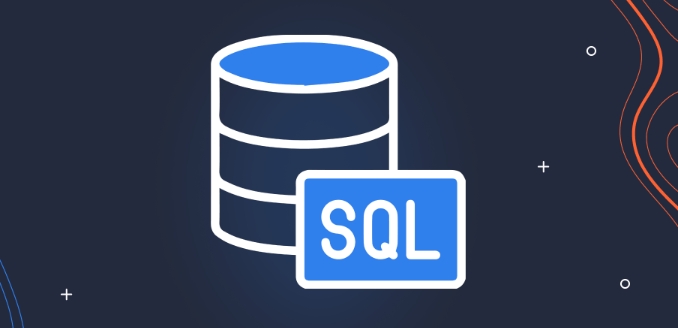The integration of AI and SQL is reshaping data analysis and decision-making methods, which are mainly reflected in three aspects: First, AI can generate SQL queries based on natural language, lowering the threshold for use; Second, AI can analyze query log recommendation index optimization to improve database performance; Third, AI can predict SQL behavior and detect abnormalities, enhancing system stability and security. Although AI enhances SQL's capabilities, the statements it generates still need to be reviewed manually, and index suggestions also need to be judged based on actual conditions. The overall trend is technical collaboration rather than substitution, which not only improves efficiency, but also lowers the technical threshold.

AI and SQL seem to be technologies in two different fields, but they are rapidly converging and becoming an important direction for future data analysis and processing. This trend not only changes the way we use databases, but also reshapes the logic of making decisions by enterprises. Next, let’s take a look at the future direction of the combination of SQL and AI from several practical perspectives.

Automated query generation: AI makes SQL "understand you" more
In the past, when writing SQL, you need to be familiar with syntax, table structure, and fields. Now, AI can directly generate SQL queries based on natural language. For example, if the user enters "Find out the product with the highest sales last month", the AI can automatically translate it into the corresponding SELECT statement.
Behind this ability is the development of natural language processing (NLP) and semantic understanding. Many BI tools and database platforms are already integrating similar functions, such as Microsoft Power BI and Google BigQuery's AI query assistant.

suggestion:
- If you are a developer, you can pay attention to some open source projects, such as Text-to-SQL models (such as BART and T5 variants).
- If you are a business person, try these AI assistants to reduce your dependence on technicians.
- But it should be noted that AI-generated SQL may sometimes be inefficient and still require manual review and optimization.
Smart index recommendation: Let the database "tune" itself
SQL query performance optimization has always been a difficult point, especially index setting. In the past, this required a lot of experience from DBA, but now AI can automatically recommend which fields should be indexed and which indexes are redundant by analyzing the query logs.

For example, Oracle's Autonomous Database and AWS's Performance Insights have already introduced such features. AI will observe historical query patterns and determine which fields are often used by WHERE, JOIN, or ORDER BY, thereby giving index suggestions.
Several key points:
- AI is not omnipotent, it depends on the quality of historical data.
- For some systems with fast query mode changes, AI may not keep up with the pace.
- It is recommended to check the index suggestions recommended by AI regularly, but do not apply them blindly.
SQL query prediction and exception detection: AI "prediction" problem in advance
In large systems, thousands of SQL queries may be executed every day. AI can learn the patterns of these queries and predict which queries may lead to performance bottlenecks or waste of resources.
For example, AI can identify that a query always slows down at a specific time, or finds that a user frequently performs full table scans. At this time, the system can be pre-warned, or even automatically optimize the execution plan or restrict resource use.
This capability is suitable for:
- Operation and maintenance monitoring of data platform.
- Stability guarantee in high concurrency business scenarios.
- Security audit, identify abnormal behaviors.
The combination of SQL and AI is not "replacement", but "enhancement"
AI will not replace SQL, but will make SQL easier to use and more efficiently executed. The database system in the future will become increasingly "smart" and can automatically handle more complex tasks, such as automatic generation of reports, optimization of query structures, and even assisting with data modeling.
For technicians, mastering SQL is still the foundation, but learning how to collaborate with AI will become a new competitive force. For enterprises, this integration means faster decision-making speed and lower technical barriers.
Basically that's it.
The above is the detailed content of SQL and AI: Future Trends. For more information, please follow other related articles on the PHP Chinese website!

Hot AI Tools

Undress AI Tool
Undress images for free

Undresser.AI Undress
AI-powered app for creating realistic nude photos

AI Clothes Remover
Online AI tool for removing clothes from photos.

Clothoff.io
AI clothes remover

Video Face Swap
Swap faces in any video effortlessly with our completely free AI face swap tool!

Hot Article

Hot Tools

Notepad++7.3.1
Easy-to-use and free code editor

SublimeText3 Chinese version
Chinese version, very easy to use

Zend Studio 13.0.1
Powerful PHP integrated development environment

Dreamweaver CS6
Visual web development tools

SublimeText3 Mac version
God-level code editing software (SublimeText3)

Hot Topics
 Defining Database Schemas with SQL CREATE TABLE Statements
Jul 05, 2025 am 01:55 AM
Defining Database Schemas with SQL CREATE TABLE Statements
Jul 05, 2025 am 01:55 AM
In database design, use the CREATETABLE statement to define table structures and constraints to ensure data integrity. 1. Each table needs to specify the field, data type and primary key, such as user_idINTPRIMARYKEY; 2. Add NOTNULL, UNIQUE, DEFAULT and other constraints to improve data consistency, such as emailVARCHAR(255)NOTNULLUNIQUE; 3. Use FOREIGNKEY to establish the relationship between tables, such as orders table references the primary key of the users table through user_id.
 What is the difference between WHERE and HAVING clauses in SQL?
Jul 03, 2025 am 01:58 AM
What is the difference between WHERE and HAVING clauses in SQL?
Jul 03, 2025 am 01:58 AM
The main difference between WHERE and HAVING is the filtering timing: 1. WHERE filters rows before grouping, acting on the original data, and cannot use the aggregate function; 2. HAVING filters the results after grouping, and acting on the aggregated data, and can use the aggregate function. For example, when using WHERE to screen high-paying employees in the query, then group statistics, and then use HAVING to screen departments with an average salary of more than 60,000, the order of the two cannot be changed. WHERE always executes first to ensure that only rows that meet the conditions participate in the grouping, and HAVING further filters the final output based on the grouping results.
 Key Differences Between SQL Functions and Stored Procedures.
Jul 05, 2025 am 01:38 AM
Key Differences Between SQL Functions and Stored Procedures.
Jul 05, 2025 am 01:38 AM
SQLfunctionsandstoredproceduresdifferinpurpose,returnbehavior,callingcontext,andsecurity.1.Functionsreturnasinglevalueortableandareusedforcomputationswithinqueries,whileproceduresperformcomplexoperationsanddatamodifications.2.Functionsmustreturnavalu
 Using SQL LAG and LEAD functions for time-series analysis.
Jul 05, 2025 am 01:34 AM
Using SQL LAG and LEAD functions for time-series analysis.
Jul 05, 2025 am 01:34 AM
LAG and LEAD in SQL are window functions used to compare the current row with the previous row data. 1. LAG (column, offset, default) is used to obtain the data of the offset line before the current line. The default value is 1. If there is no previous line, the default is returned; 2. LEAD (column, offset, default) is used to obtain the subsequent line. They are often used in time series analysis, such as calculating sales changes, user behavior intervals, etc. For example, obtain the sales of the previous day through LAG (sales, 1, 0) and calculate the difference and growth rate; obtain the next visit time through LEAD (visit_date) and calculate the number of days between them in combination with DATEDIFF;
 How to find columns with a specific name in a SQL database?
Jul 07, 2025 am 02:08 AM
How to find columns with a specific name in a SQL database?
Jul 07, 2025 am 02:08 AM
To find columns with specific names in SQL databases, it can be achieved through system information schema or the database comes with its own metadata table. 1. Use INFORMATION_SCHEMA.COLUMNS query is suitable for most SQL databases, such as MySQL, PostgreSQL and SQLServer, and matches through SELECTTABLE_NAME, COLUMN_NAME and combined with WHERECOLUMN_NAMELIKE or =; 2. Specific databases can query system tables or views, such as SQLServer uses sys.columns to combine sys.tables for JOIN query, PostgreSQL can be used through inf
 Can You Provide Code Examples Demonstrating Pattern Matching in SQL?
Jul 04, 2025 am 02:51 AM
Can You Provide Code Examples Demonstrating Pattern Matching in SQL?
Jul 04, 2025 am 02:51 AM
Pattern matching functions in SQL include LIKE operator and REGEXP regular expression matching. 1. The LIKE operator uses wildcards '%' and '_' to perform pattern matching at basic and specific locations. 2.REGEXP is used for more complex string matching, such as the extraction of email formats and log error messages. Pattern matching is very useful in data analysis and processing, but attention should be paid to query performance issues.
 How to create a user and grant permissions in SQL
Jul 05, 2025 am 01:51 AM
How to create a user and grant permissions in SQL
Jul 05, 2025 am 01:51 AM
Create a user using the CREATEUSER command, for example, MySQL: CREATEUSER'new_user'@'host'IDENTIFIEDBY'password'; PostgreSQL: CREATEUSERnew_userWITHPASSWORD'password'; 2. Grant permission to use the GRANT command, such as GRANTSELECTONdatabase_name.TO'new_user'@'host'; 3. Revoke permission to use the REVOKE command, such as REVOKEDELETEONdatabase_name.FROM'new_user
 How to backup and restore a SQL database
Jul 06, 2025 am 01:04 AM
How to backup and restore a SQL database
Jul 06, 2025 am 01:04 AM
Backing up and restoring SQL databases is a key operation to prevent data loss and system failure. 1. Use SSMS to visually back up the database, select complete and differential backup types and set a secure path; 2. Use T-SQL commands to achieve flexible backups, supporting automation and remote execution; 3. Recovering the database can be completed through SSMS or RESTOREDATABASE commands, and use WITHREPLACE and SINGLE_USER modes if necessary; 4. Pay attention to permission configuration, path access, avoid overwriting the production environment and verifying backup integrity. Mastering these methods can effectively ensure data security and business continuity.






